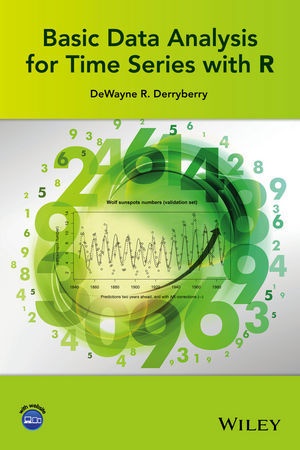Read more
Written at a readily accessible level, Basic Data Analysis for Time Series with R emphasizes the mathematical importance of collaborative analysis of data used to collect increments of time or space. Balancing a theoretical and practical approach to analyzing data within the context of serial correlation, the book presents a coherent and systematic regression-based approach to model selection. The book illustrates these principles of model selection and model building through the use of information criteria, cross validation, hypothesis tests, and confidence intervals.
Focusing on frequency- and time-domain and trigonometric regression as the primary themes, the book also includes modern topical coverage on Fourier series and Akaike's Information Criterion (AIC). In addition, Basic Data Analysis for Time Series with R also features:
* Real-world examples to provide readers with practical hands-on experience
* Multiple R software subroutines employed with graphical displays
* Numerous exercise sets intended to support readers understanding of the core concepts
* Specific chapters devoted to the analysis of the Wolf sunspot number data and the Vostok ice core data sets
List of contents
PREFACE xv
ACKNOWLEDGMENTS xvii
PART I BASIC CORRELATION STRUCTURES
1 RBasics 3
1.1 Getting Started, 3
1.2 Special R Conventions, 5
1.3 Common Structures, 5
1.4 Common Functions, 6
1.5 Time Series Functions, 6
1.6 Importing Data, 7
Exercises, 7
2 Review of Regression and More About R 8
2.1 Goals of this Chapter, 8
2.2 The Simple(ST) Regression Model, 8
2.3 Simulating the Data from a Model and Estimating the Model Parameters in R, 9
2.4 Basic Inference for the Model, 12
2.5 Residuals Analysis--What Can Go Wrong..., 13
2.6 Matrix Manipulation in R, 15
Exercises, 16
3 The Modeling Approach Taken in this Book and Some Examples of Typical Serially Correlated Data 18
3.1 Signal and Noise, 18
3.2 Time Series Data, 19
3.3 Simple Regression in the Framework, 20
3.4 Real Data and Simulated Data, 20
3.5 The Diversity of Time Series Data, 21
3.6 Getting Data Into R, 24
Exercises, 26
4 Some Comments on Assumptions 28
4.1 Introduction, 28
4.2 The Normality Assumption, 29
4.3 Equal Variance, 31
4.4 Independence, 31
4.5 Power of Logarithmic Transformations Illustrated, 32
4.6 Summary, 34
Exercises, 34
5 The Autocorrelation Function And AR(1), AR(2) Models 35
5.1 Standard Models--What are the Alternatives to White Noise?, 35
5.2 Autocovariance and Autocorrelation, 36
5.3 The acf() Function in R, 37
5.4 The First Alternative to White Noise: Autoregressive Errors--AR(1), AR(2), 40
Exercises, 49
6 The Moving Average Models MA(1) And MA(2) 51
6.1 The Moving Average Model, 51
6.2 The Autocorrelation for MA(1) Models, 51
6.3 A Duality Between MA(l) And AR(m) Models, 52
6.4 The Autocorrelation for MA(2) Models, 52
6.5 Simulated Examples of the MA(1) Model, 52
6.6 Simulated Examples of the MA(2) Model, 54
6.7 AR(m) and MA(l) model acf() Plots, 54
Exercises, 57
PART II ANALYSIS OF PERIODIC DATA AND MODEL SELECTION
7 Review of Transcendental Functions and Complex Numbers 61
7.1 Background, 61
7.2 Complex Arithmetic, 62
7.3 Some Important Series, 63
7.4 Useful Facts About Periodic Transcendental Functions, 64
Exercises, 64
8 The Power Spectrum and the Periodogram 65
8.1 Introduction, 65
8.2 A Definition and a Simplified Form for p(f ), 66
8.3 Inverting p(f ) to Recover the Ck Values, 66
8.4 The Power Spectrum for Some Familiar Models, 68
8.5 The Periodogram, a Closer Look, 72
8.6 The Function spec.pgram() in R, 75
Exercises, 77
9 Smoothers, The Bias-Variance Tradeoff, and the Smoothed Periodogram 79
9.1 Why is Smoothing Required?, 79
9.2 Smoothing, Bias, and Variance, 79
9.3 Smoothers Used in R, 80
9.4 Smoothing the Periodogram for a Series With a Known and Unknown Period, 85
9.5 Summary, 87
Exercises, 87
10 A Regression Model for Periodic Data 89
10.1 The Model, 89
10.2 An Example: The NYC Temperature Data, 91
10.3 Complications 1: CO2 Data, 93
10.4 Complications 2: Sunspot Numbers, 94
10.5 Complications 3: Accidental Deaths, 96
10.6 Summary, 96
Exercises, 96
11 Model Selection and Cross-Validation 98
11.1 Background, 98
About the author
DeWayne R. Derryberry, PhD, is Associate Professor in the Department of Mathematics and Statistics at Idaho State University. Dr. Derryberry has published more than a dozen journal articles and his research interests include meta-analysis, discriminant analysis with messy data, time series analysis of the relationship between several cancers, and geographically-weighted regression.
Summary
Written at a readily accessible level, Basic Data Analysis for Time Series with R emphasizes the mathematical importance of collaborative analysis of data used to collect increments of time or space.

